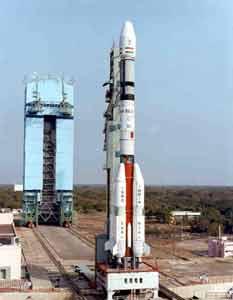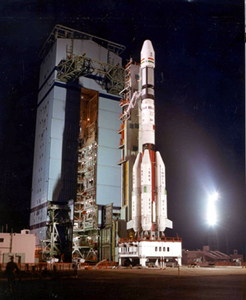Government clears funding for six GSLV flights
17 Jul 2008
 The Union Cabinet today cleared the funding for the operational flights of six geo-stationary satellite launch vehicles (GSLV), numbers F11 to F16, at a total estimated cost of Rs1280.96 crore. The funding also involves a foreign exchange component of Rs272.90 crore. The GSLV flights will be made to cater to the growing need for satellite transponders that will offer meteorological and navigational services.
The Union Cabinet today cleared the funding for the operational flights of six geo-stationary satellite launch vehicles (GSLV), numbers F11 to F16, at a total estimated cost of Rs1280.96 crore. The funding also involves a foreign exchange component of Rs272.90 crore. The GSLV flights will be made to cater to the growing need for satellite transponders that will offer meteorological and navigational services.
With these six operational flights end-to-end capability to launch communication satellites will become available during the Eleventh Five Year Plan. The six flights will take place in the period 2010-1012.
Currently, the Indian National Satellite (INSAT) system has 211 transponders while expected demand by end of the 11th Plan is expected to go up to about 500. During this period, and beyond, ISRO is likely to launch 12 GSAT series of satellites onboard the current version of the GSLV, at the rate of two a year.
Approval already exists for six GSLV flights, numbers F1 to F10, in the current operational programme.
GSLV
The GSLV attained operational status during 2004 after successfully completing two demonstration flights. In its first operational flight, the GSLV-F01 successfully launched the 1950 kg EDUSAT satellite into Geo-synchronous Transfer Orbit (GTO). More recently, in September 2007, the GSLV in its F04 flight successfully carried a 2130 kg communication satellite, the INSAT-4CR.
The GSLV, in its operational role, has so far completed three flights, of which two have been successful.
With four successful flights so far, the GSLV is poised to launch a series of 2200-2400 kg class communication satellites during the eleventh Five-Year Plan period and beyond.
 The next mission will see the launch of the GSLV-D3 sometime this year, which will also see the rocket carrying the indigenously developed Cryogenic Upper Stage (CUS). The mission will launch the GSAT-4 satellite into GTO.
The next mission will see the launch of the GSLV-D3 sometime this year, which will also see the rocket carrying the indigenously developed Cryogenic Upper Stage (CUS). The mission will launch the GSAT-4 satellite into GTO.
The GSLV project aims at developing the capability of carrying 2 tonne class communication satellites into GTO. The project provided for the design, development and launch of three developmental flights, D1, D2 and D3.
Starting from the Mark1 version of the GSLV, payloads have gradually improved from 1540 kg to 2150 kg through the use of S139 solid core stage, high performance liquid engines, miniaturized avionics and mission optimization.
Plans are afoot to increase the payload capability to 2400 kg in subsequent flights through the use of indigenous Cryogenic Upper Stage.













.jpg)






.jpg)









